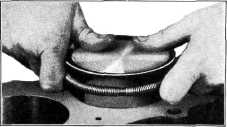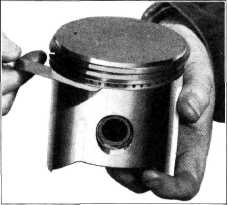1942 - 1947 CHEVROLET SHOP MANUAL
Section 6 - Engine
|
|
|||
|
6-6 |
|||
|
|
|||
|
Carefully
remove all particles of carbon from the ring grooves in the piston, and
inspect the grooves carefully for
burrs or nicks that might cause the rings to hang
up.
Slip the
outer surface of the ring into the piston ring groove and roll the ring entirely
around the groove to make sure that the ring is free and does not bind in the groove at any point, Fig. 7.
If binding occurs the cause
should be determined and removed by careful dressing with a fine-cut
file. However, if the binding
is caused by a distorted ring,
install a new ring.
Proper
clearance of the piston ring in its piston ring groove is very important in maintaining
engine performance and in
preventing excessive oil consumption. Therefore, when fitting new
rings, the following
clearances between the top and bottom surfaces and the ring grooves should be
provided:
The two
compression rings should be fitted so that a .0015" feeler gauge will be free, but
a .003" feeler will cause a
rather heavy drag.
At the
bottom, or oil control groove, a .002" feeler should be free but a .0035" feeler
should produce a heavy drag.
It is
important that each ring be fitted to its individual cylinder for gap spacing and its
individual piston and
groove for clearances. A final test of the ring fit in the grooves is to
repeat the fitting procedure
given above after the rings are assembled in the grooves of the
pistons, Fig. 8. |
chamfer on
the bottom of the inserter must fit into the chamfer at the top of the
cylinder. |
||
 |
|||
|
Fig. 9—Inserting Piston in Cylinder Bore
MAIN BEARINGS
Chevrolet
main bearings are steel back babbitt-lined. The babbitt is centrifugally cast or
"spun-in" into the steel
lining. This method assures a positive bond between the steel and the
babbitt and also prevents the
formation of air pockets in the babbitt metal.
The
advantage of this type bearing is that the rate of expansion is similar to that of the
parts with which they come in
contact. This prevents loosening of the bearings. The thin wall of
the bearing permits it to conform to both the crankshaft and the bearing bore in the cylinder
block, assuring a snug fit at
all times. Both of these important features of Chevrolet main bearings
insure long
life. |
|||
|
|
|||
 |
 |
||
|
Fig. 8—Checking Piston Ring Clearance in Ring
Groove
In slipping
the pistons back into the cylinders, use extreme care and do not force the rings
into the bore. Compress the rings with the piston inserter as shown in Fig. 9, until they enter
the cylinder freely. In using
this piston inserter the |
|||
|
Fig. 10—Main Bearing Boring Machine
When
necessary to replace main bearings, the clutch housing should not be
removed from the cylinder block. This is very important, as the transmission pilot hole in the clutch
housing is used in aligning
the boring bar. Should it be |
|||
|
|
|||